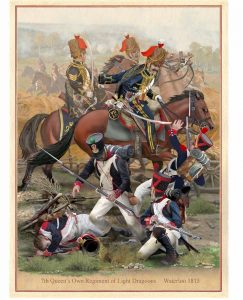Waterloo
On Napoleon’s escape from Elba in March 1815, England again declared war on France and, by the 25th of that month, the 7th Hussars had again departed for Belgium.
On June 17th the 7th was engaged in the action at Genappe, where they “most gallantly” attempted an impossible task. The British rearguard had scarcely cleared the village of Genappe when Napoleon’s vanguard began to debouch from the narrow main street.
This body was Napoleon’s famous Polish Lancers, and they entirely blocked the street; a mass of lance heads, impregnable and with no flanks. The 7th, to give the main body more time to get away, wheeled around to attack the enemy. Time and again, losing heavily, the Hussars charged the enemy lances and were repulsed, finally withdrawing.
Once, however, the foe did come out of the village street and their flanks exposed they were cut to pieces by the Life Guards.
The following day, June 18th, the 7th was present at the Battle of Waterloo.
Waterloo 18 June 1815
The 7th Hussars fought at the end of this the final crushing defeat of Napoleon’s Army and his ambitions for a conquered Europe.
The 7th was posted behind a ridge half a mile north of the Chateau Hougoumont and near the Louvain, near Wellington’s right flank. In front lay Byng’s infantry brigade.
In the early hours of the action, the 7th was employed in combating enemy cavalry attacks on the British squares in front of them and made over a dozen brilliant charges one of which they cut off a squadron of Napoleon’s Cuirassiers and killed them almost to the last man.

7th Hussars at Waterloo
When, towards evening, Wellington ordered the general advance, the 7th, under terrific fire and suffering heavily in casualties, charged all types of Napoleonic troops – artillery, cavalry and infantry.
Woefully depleted in numbers, they then linked themselves with Vivan’s brigade and aided that body to destroy three squadrons of French cavalry who dared to stand up to them in their victorious career.
The next day the regiment, now a mere remnant of its original strength, went in pursuit of the flying French, then headlong in their flight towards Paris.
The loss to the regiment on June 17th and 18th was 56 rank and file and 84 horses killed, and 6 officers, 93 rank and file and 116 horses wounded.
The regiment then formed part of the Army of Occupation in France and remained with that force until 1818, when it marched to Calais and embarked for England.
Campaign Medal
 The Waterloo Medal was issued in 1816–1817 to every soldier present at one or more of the battles of Ligny, Quatre Bras and Waterloo. Each soldier was also credited with two years extra service and pay, to count for seniority and pension purposes, and was to be known as “Waterloo Men”.
The Waterloo Medal was issued in 1816–1817 to every soldier present at one or more of the battles of Ligny, Quatre Bras and Waterloo. Each soldier was also credited with two years extra service and pay, to count for seniority and pension purposes, and was to be known as “Waterloo Men”.
This was the first medal issued by the British Government to all soldiers present during an action. The Military General Service Medal commemorates earlier battles but was not issued until 1848.
The Waterloo Medal was also the first campaign medal awarded to the next-of-kin of men killed in action.

